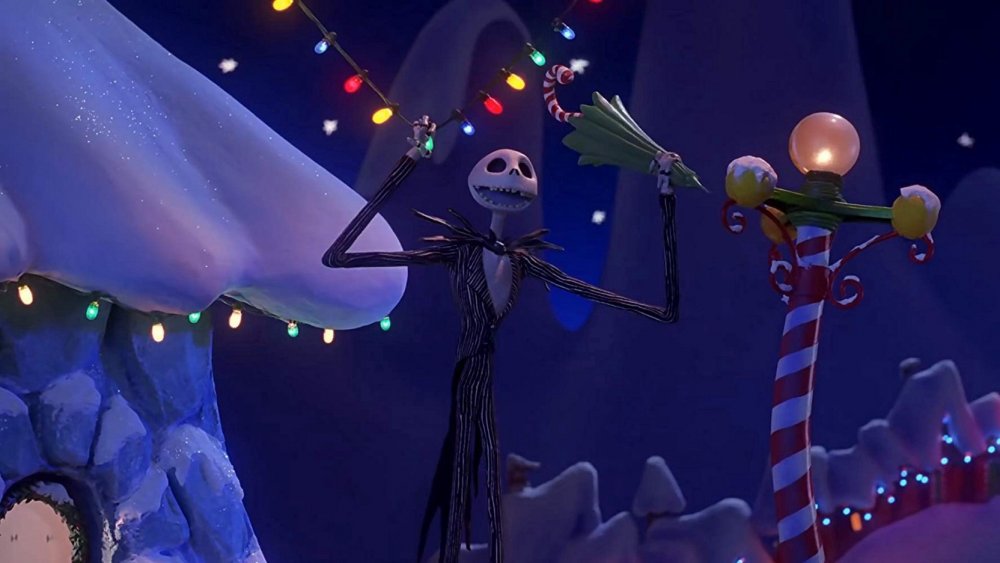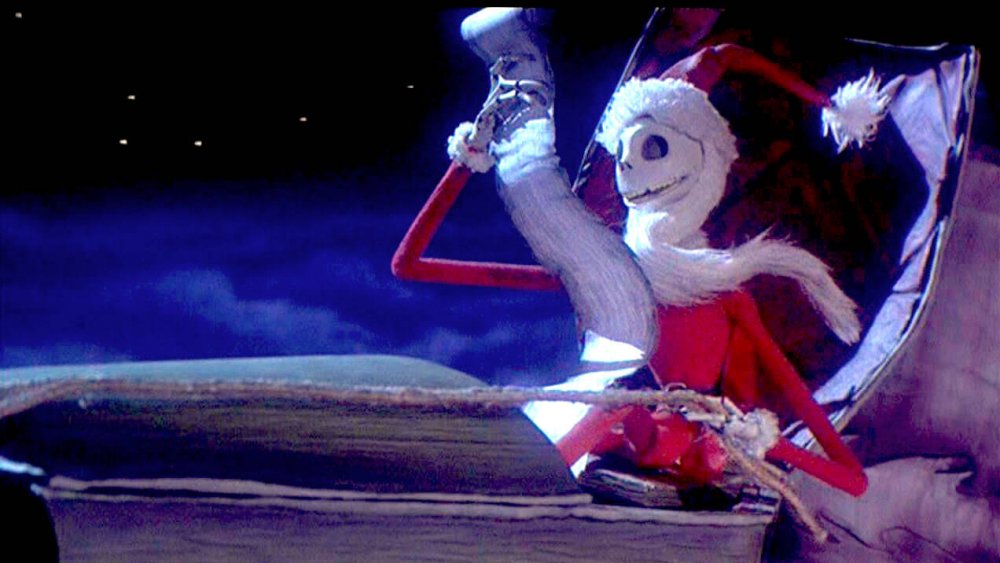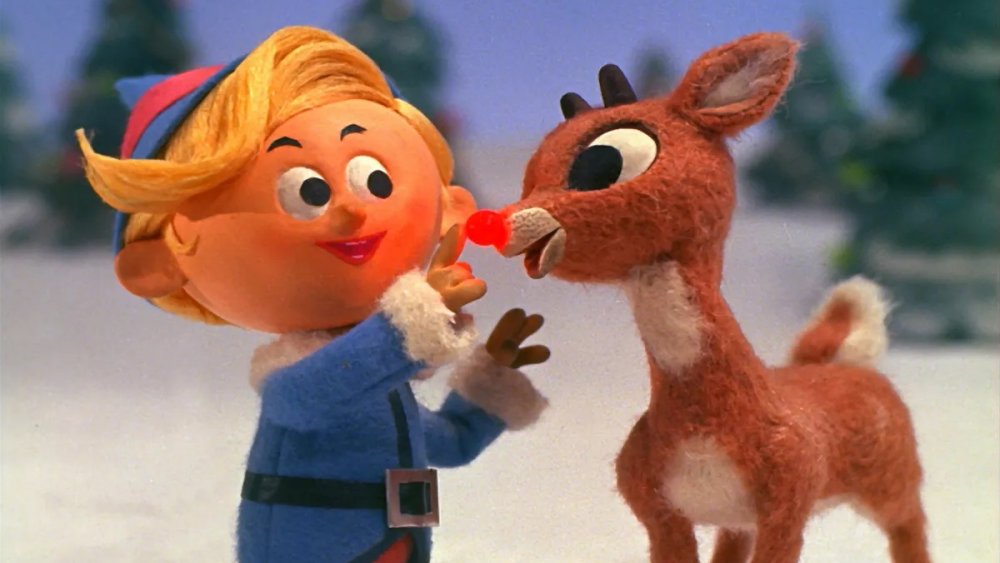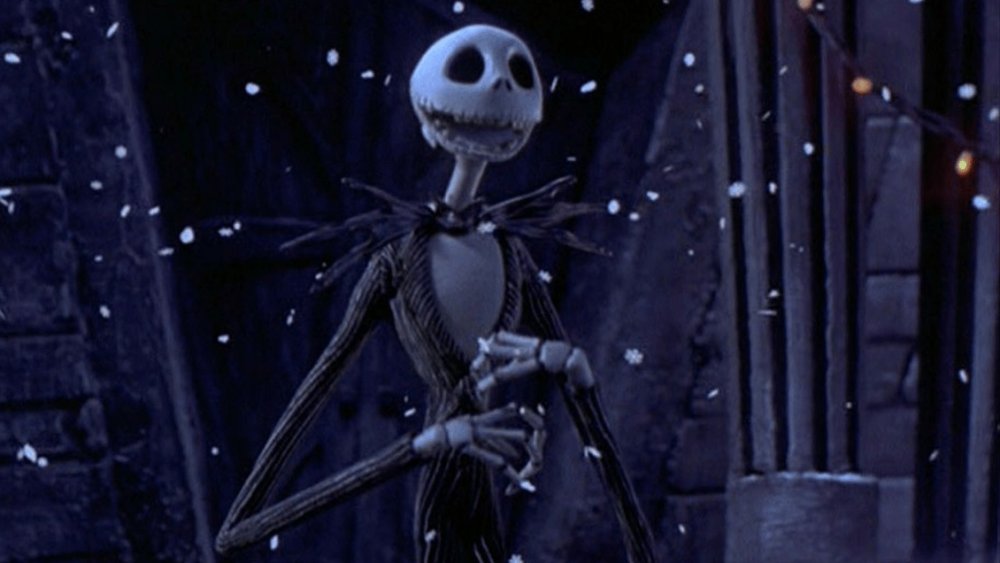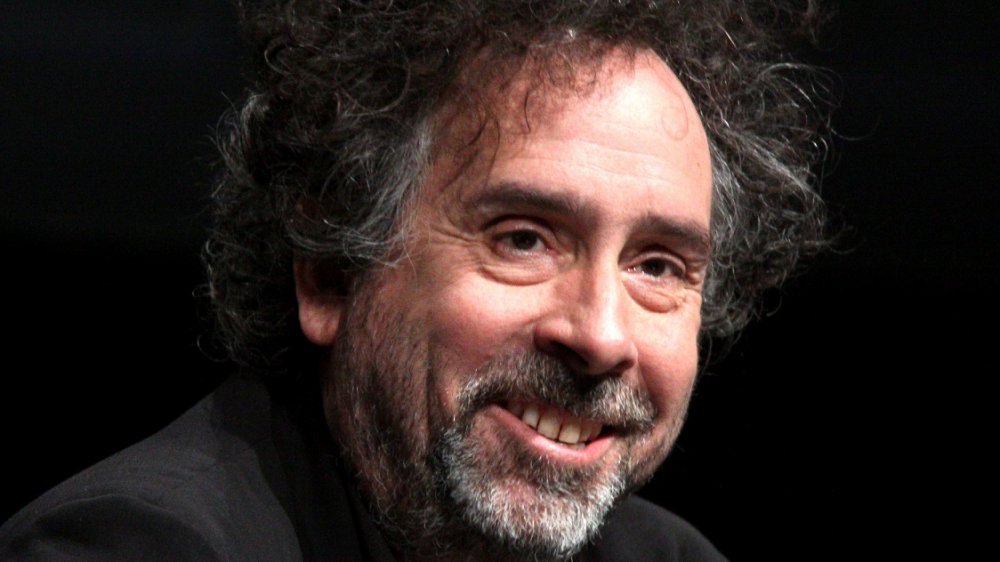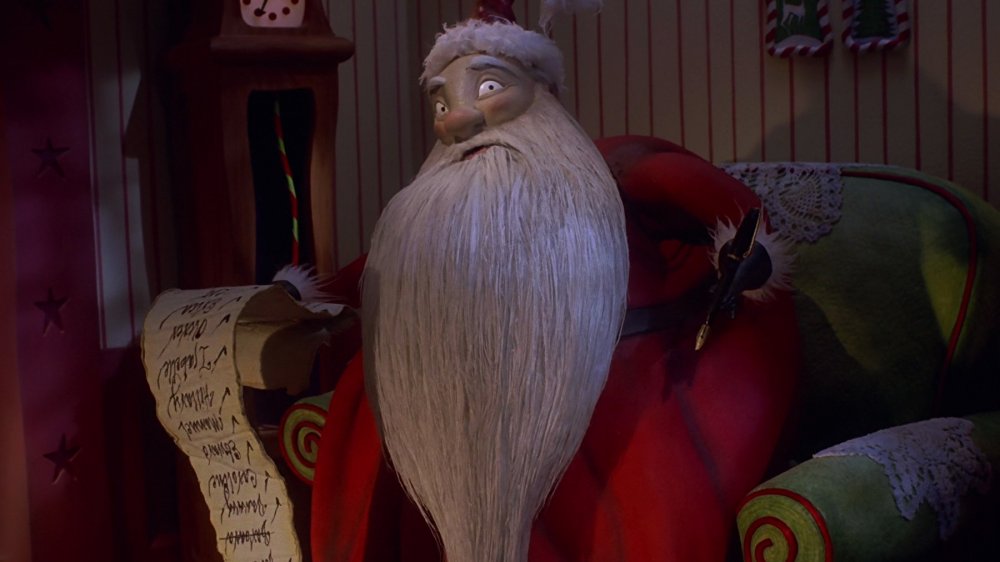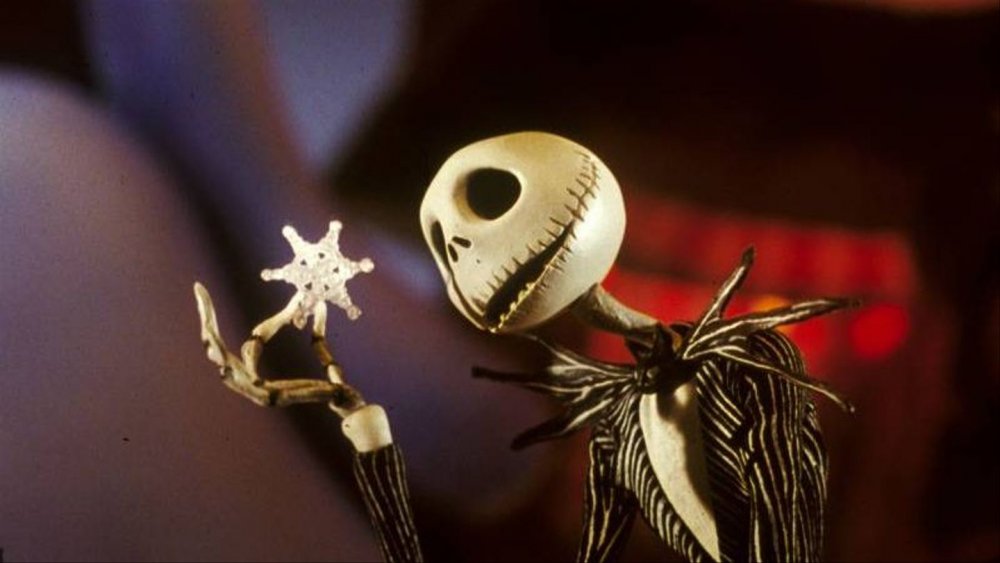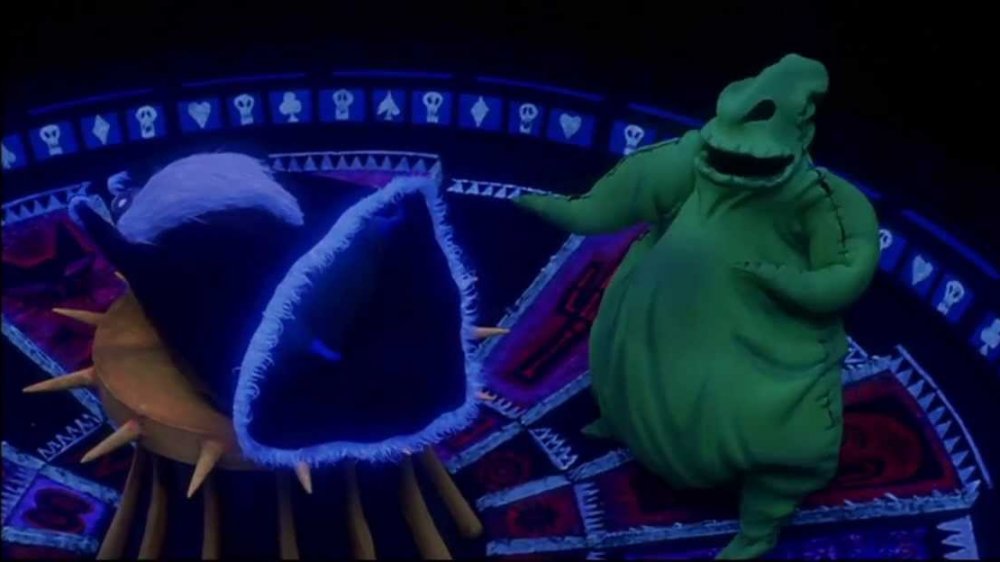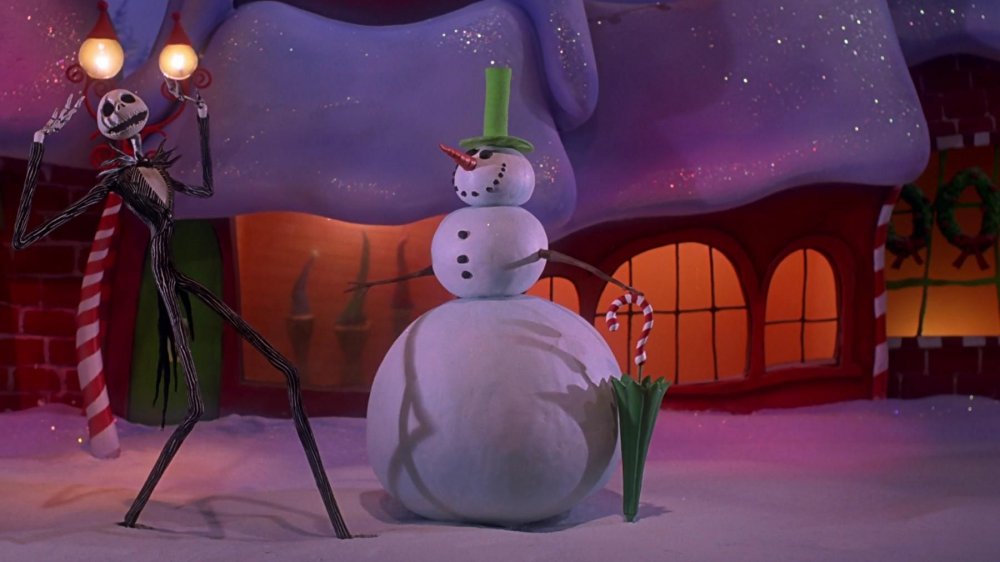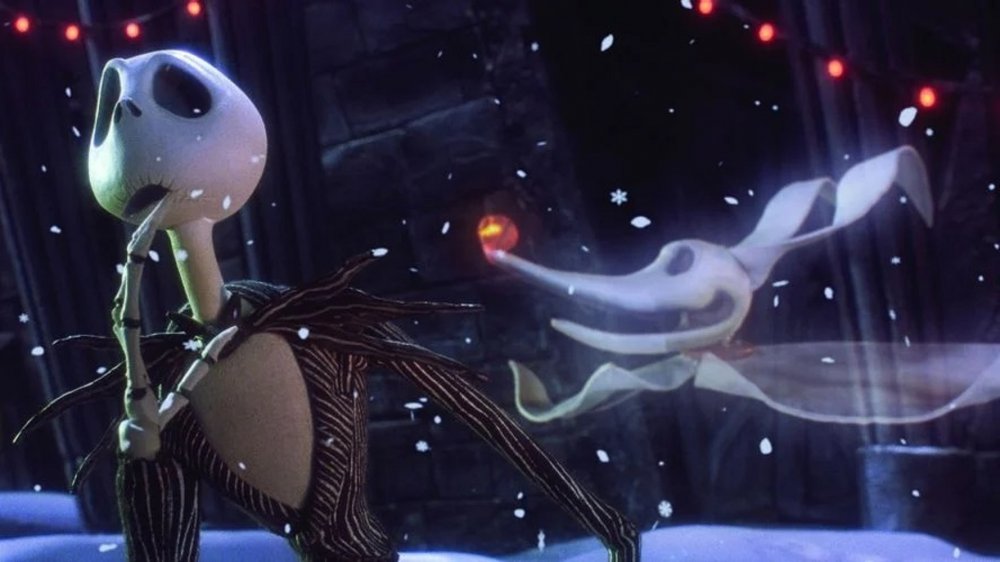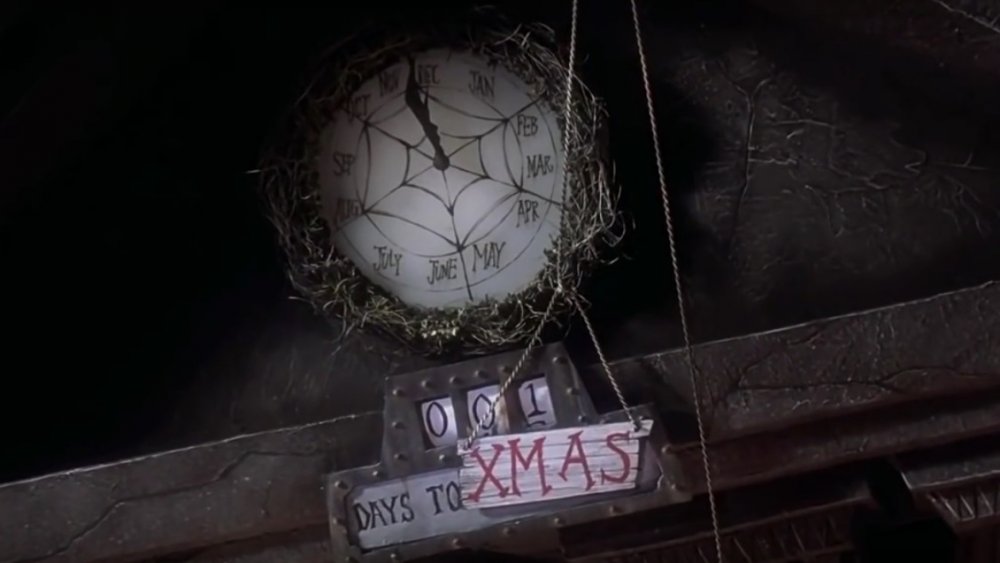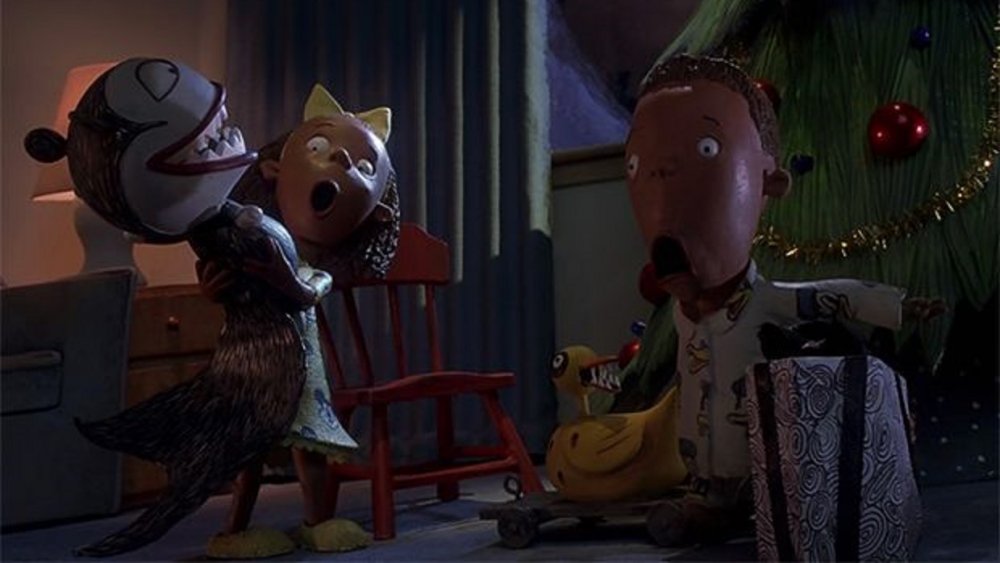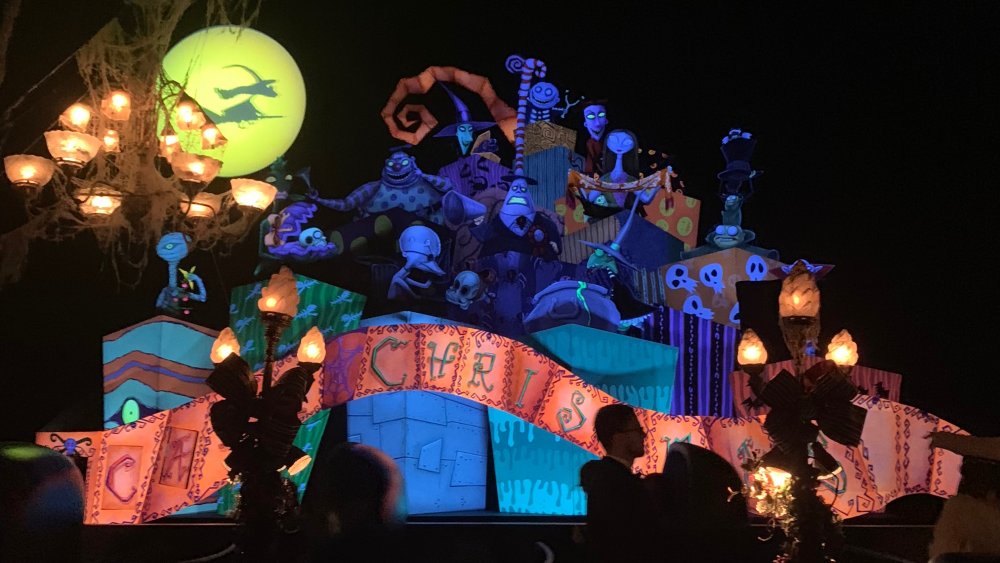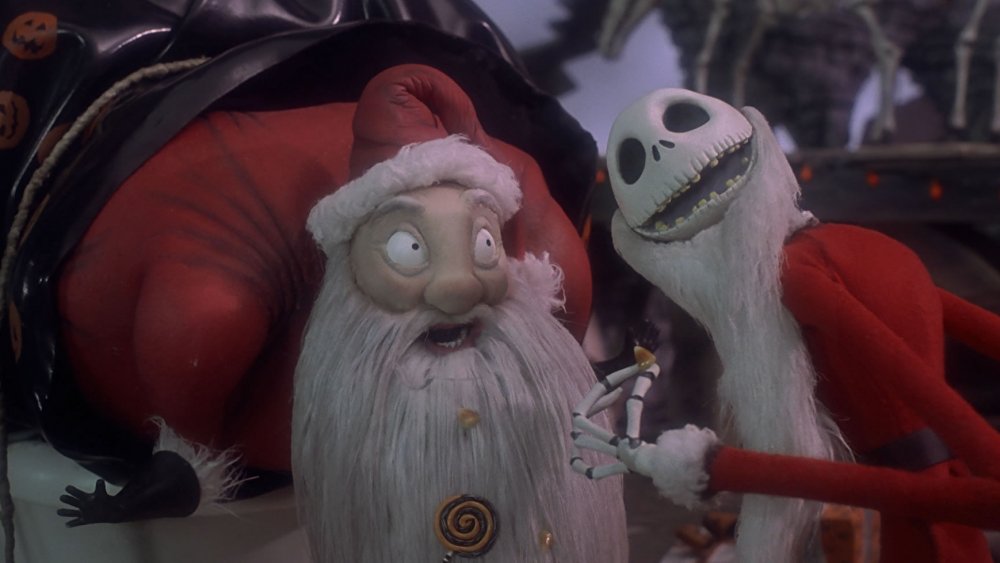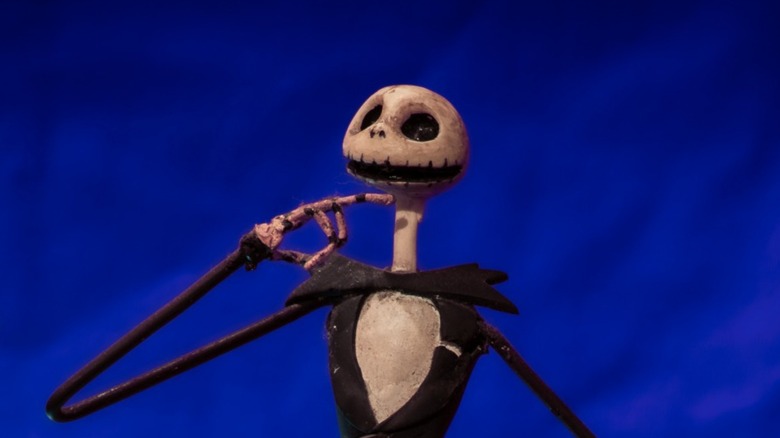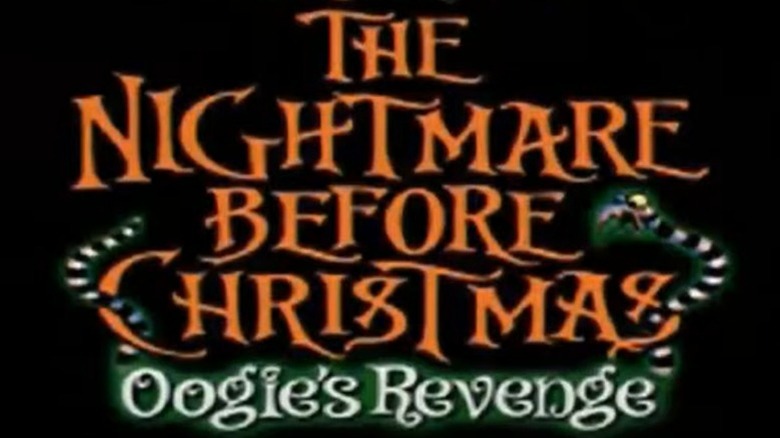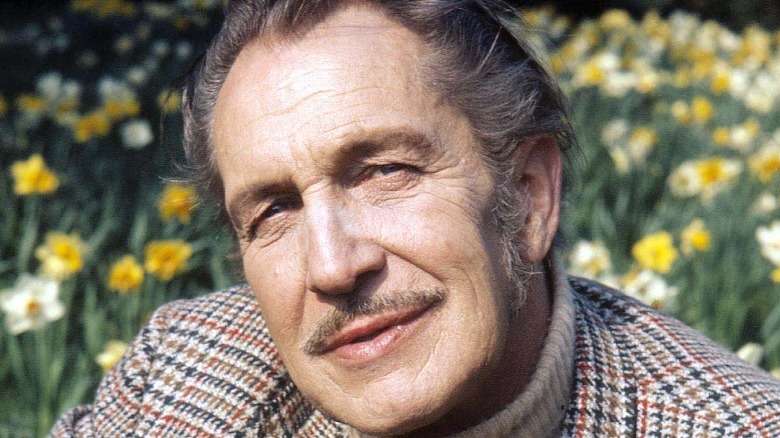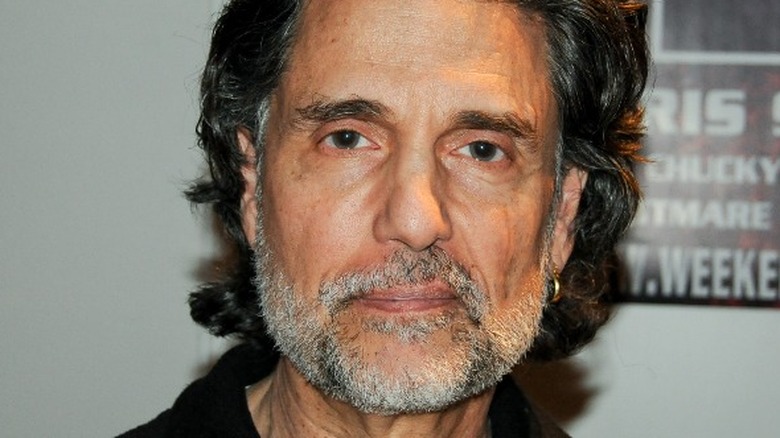The Nightmare Before Christmas: 18 Spooky Facts About The Movie
In October 1993, movie fans were treated to "The Nightmare Before Christmas," and no Halloween since has been complete without at least one re-watch. (Or should that be no Christmas?) The story of Pumpkin King Jack Skellington and his terrifying take on festive cheer was originally given a limited release in theaters by Disney, which was scared stiff of losing its family-friendly reputation. However, the creepy-yet-cute stop-motion musical still managed to draw a respectable crowd, and over the next few decades, it became an indisputable classic. Composer (and Jack's singing voice) Danny Elfman wrote the song's catchy soundtrack in a month, while director Henry Selick (no, not Tim Burton) and his dedicated team storyboarded, modeled, molded, fabricated, and animated hundreds of puppets and their world over three grueling years.
Disney's disturbing lack of faith in a movie it deemed too dark for children, undermined the film's release. However, the studio's atypical hands-off approach also gave the creators the chance to explore and experiment without having to justify it to nervous executives. That said, bringing Tim Burton's original vision to the screen produced a lot of fun (and nightmarish) challenges. Here's the untold truth of "The Nightmare Before Christmas," through script troubles, voiceover drama, hidden details, and its rise from Disney's unwanted stepchild to a beloved annual theme park attraction.
Nightmare started as a poem by Tim Burton
"The Nightmare Before Christmas" took more than its title from the famous Christmas Eve poem. Tim Burton wrote the first version of the story in verse, with a similar rhyming pattern. His poem introduced Jack Skellington and Zero, and Santa was still kidnapped by some badly behaved trick-or-treaters: but none of the other residents of Halloween Town (including Sally) were mentioned by name. Along with the poem, Burton made some early sketches of the characters.
At the time, Burton was working for the Disney animation department. As the Hollywood Reporter writes, he pitched his poem to the studio as a TV special in the '80s, but Disney rejected it, saying it wasn't in keeping with its typically warm and fuzzy style.
Fed up with cutesy animation, Burton eventually left Disney to pursue his own projects. Starting with 1985's "Pee-Wee's Big Adventure," he went on an incredibly successful run. Burton's next three films were "Beetlejuice" in 1988, "Batman" (starring Michael Keaton and Jack Nicholson) in 1989, and "Edward Scissorhands" in 1990.
With Burton having proved that his personal brand of out-there was a box office draw, Disney was suddenly interested in investing in that weird little story he'd once told them about a skeleton who wants to be Santa. To an extent: Disney distanced itself from Nightmare by releasing it through its "grown-up" label Touchstone.
The Nightmare Before Christmas drew on a variety of references
Finding the right feel for a story that celebrates both Christmas coziness and Halloween horror required a range of influences. In a behind-the-scenes video, Burton said that he was inspired by the holiday specials he'd loved watching while growing up, notably Rankin/Bass's stop-motion Christmas staple "Rudolph the Red-Nosed Reindeer," and "How the Grinch Stole Christmas!," a 1966 animated adaptation of the Dr. Seuss tale. Burton told the behind-the-scenes video that he sees "Nightmare" as a reverse of "Grinch": "about this character who finds Christmas and loves it and decides to try to do it himself."
However, because this is Tim Burton and Halloween, there are also some more gothic inspirations in the characters he cooked up. Director Henry Selick told Yahoo that Burton was "somewhat influenced by Charles Addams," creator of — you guessed it — the Addams family. The movie's art directors also wanted to channel Edward Gorey and Ronald Searle — both famous for their macabre, stylized pen-and-ink drawings — into the texture of the scenery. Selick told the behind-the-scenes video that they would lay down clay or plaster on the sets and scratch lines into it, which looked like pencil marks reminiscent of Gorey and Searle's work.
Danny Elfman related to Jack Skellington
Oscar-nominated composer Danny Elfman clicked instantly with Burton's vision for "The Nightmare Before Christmas." Although there was no script when Elfman was brought on, Burton had amassed a collection of drawings and poems that served as very effective inspiration. "It turned out to be the simplest writing I'd ever done ... a number of times I pushed him out the door because I started hearing the songs in my head," Elfman told Billboard in 2018. He drew from older musical scores by Cole Porter, George Gershwin, Rodgers and Hammerstein, and Gilbert and Sullivan.
Elfman ultimately took on an even greater role in the movie. While laying down vocals on the demos, he realized he really wanted to voice Jack. He later told MTV that Jack's predicament as the leader of a town he's no longer truly committed to felt similar to his own situation, as the increasingly reluctant frontman of the band Oingo Boingo. Their personalities were similar, too. He told E!: "Getting very enthusiastic and then plunging down into this melancholy state — I mean, that's me."
Fortunately, Burton agreed. However, he brought in actor Chris Sarandon (a.k.a. Prince Humperdinck of "The Princess Bride") to voice Jack's non-singing scenes. Director Selick told The Daily Beast that Elfman was hurt at having some of his vocals replaced, but he and Burton made up.
Tim Burton was barely on the set of The Nightmare Before Christmas
If you've always thought that Tim Burton directed "The Nightmare Before Christmas," it's not your fault. Burton came up with the story and a lot of the artwork in the '80s. But when Disney finally greenlit the movie, he was busy prepping "Batman Returns." Instead, he enlisted his friend and fellow director, Henry Selick.
Selick and Burton had studied and worked together at the animation school CalArts and at Disney. Like Burton, Selick's sensibilities leaned more spooky than cutesy: "But we were ... trying to draw cute foxes for 'The Fox and the Hound,'" he told The Hollywood Reporter.
Selick credits Burton with developing the story, the main characters, the tone, and the look, but he was the one on set every day, managing the 120-person crew.
The confusion doesn't only come from the fact "Nightmare" looks and feels like such a typical Tim Burton movie. Disney and Touchstone intentionally marketed the movie as Tim Burton's "The Nightmare Before Christmas." Burton later admitted he "wasn't quite sure" about this. Selick told The Daily Beast, "That bothered me for a while ... I was shoved pretty far in the background [of the title sequence], which threw me, but it was probably a good marketing decision." Selick went on to direct more whimsically weird stop-motion classics: 1996's "James and the Giant Peach" and 2009's Oscar-nominated "Coraline."
The Night Before Christmas script was late
Tim Burton had his poem and a vivid vision of "The Nightmare Before Christmas" — but no script. By July 1991, Selick and his crew had moved into an unmarked warehouse in San Francisco. Shooting had to start on October 1, but all they had of the story was an outline, which Elfman and Burton used to write the songs. It took about a month to write and demo all 10. Unable to wait any longer, Selick started animating the three songs that were ready first, beginning with "What's This?"
The first screenwriter tasked with combining the songs into a script was Michael McDowell, who had co-written "Beetlejuice," but Selick told The Daily Beast that McDowell was ultimately too ill to finish the project. Instead, Caroline Thompson stepped in. She'd previously written "Edward Scissorhands" (scored by Elfman) and 1991's "The Addams Family," and would later co-write Burton's "Corpse Bride."
Thompson said that by the time she joined, all the songs were finished and they were animating "Kidnap the Sandy Klaws." Her first visit to the incredible set inspired a plotline. She was fascinated by a character in Halloween Town who had flipped open his head to scratch his brain. "Right then and there, Sally's story came into focus and Dr. Finkelstein was born," she told D23.
Disney wanted Jack Skellington to have eyes
Jack Skellington had been a part of "The Nightmare Before Christmas" since Burton's poem, but it took a few small tweaks to get him right. Burton's first sketches of Jack showed him as even thinner than the final, spindly character we all love and slightly fear. Selick told Yahoo that Burton originally wanted Jack to be wearing all black, but that made him blend into the background of Halloween Town. After trying a few different color palettes, Selick settled on Jack's pinstripe suit (the bat bowtie was referenced in the original poem.)
One thing Selick wouldn't change was Jack's face. A few people at Disney tried to make him and Burton give Jack eyeballs, but they refused. Instead, as Selick explained to Yahoo, "we made the sockets of his eyes ... this dark, soft, reflective surface. It's very subtle, but there's sort of a glow in there."
There were two major inspirations behind Jack's long-legged, graceful movements — dancer Fred Astaire, and Selick himself. He told Yahoo, "if you ever meet me, he kind of moves like me — better than me, more Fred Astaire than I'll ever be!" This helped with the animation process: Animators often act out their character's movements to help them work out where to place each limb. As Selick put it to Yahoo, animators "are all actors who act through the characters."
Making and moving each puppet was harder than you'd think
Each of the puppets in "The Nightmare Before Christmas" started life as a drawing by the art department. Many came from Burton's original pitch to Disney. Next, the sculptors turned the sketch into a 3D model made from oil-based clay, which was then used to make a plaster mold.
Meanwhile, an engineer made the puppet's armature: The metal "skeleton" inside a stop-motion puppet that allows it to hold its shape and bend. The armature was placed inside the mold, which was filled with foam latex and baked. The puppet's final stop before the set was the fabrication department, where it was painted and given hair — or fur — and clothing. Each of the characters had three to four duplicates, making for close to 200 puppets in total.
Once the puppets were on set, the animators had to be able to move them without disturbing anything else in the scene. The sets were designed so they wouldn't have to reach more than 2.5ft to get to their puppet, with hidden trapdoors making it easier to reach up from below.
Evil Oogie Boogie caused problems for people other than Santa, Jack, and Sally. Selick said the villain was the hardest puppet to make and animate. "It's like a wrestling match to animate a puppet that size, with huge metal joints inside him. So it really pushed the limits of what we could do," he told Yahoo.
A construction project down the street nearly derailed The Nightmare Before Christmas
One of the trickiest things about stop-motion is that the tiniest little movement of the set, puppet, background, camera, or lighting can destroy a whole sequence. The slightest slip shows up when you play it all back, animator Mike Belzer told a behind-the-scenes video, "and that sometimes is a shot-killer."
Given this need for absolute stillness, Belzer experienced a nightmare of his own early in the shoot. As he told D23, the first scene he animated for the movie was "What's This?" While he was working on the sequence in which Jack dances around the snowman, he realized as he went to move the skeleton puppet that it was shaking slightly.
No, it wasn't a ghost visiting from Halloween Town. Down the block, construction workers were pile-driving into the ground. "Each time they pounded the girder it shook the whole neighborhood," Belzer said. "I freaked out, [wondering] 'How can we make a stop motion film with this going on?'"
He consulted Selick, who told him to take each frame once Jack had settled. That worked, and the pile-driving stopped a week or two later. On your next re-watch of that scene, "you may notice a little soft motion blur around some of the characters where perhaps we didn't expose the frame at the right time," Belzer said.
The animators relied on clever old-school tricks
Being a creative, old-school group, the crew on "The Nightmare Before Christmas" came up with creative, old-school approaches to various problems they ran into during production.
For example, how to create Zero, Jack's loyal, red-nosed ghost dog. Selick explained to Yahoo that Zero's face, nose, and head were made from the same foam latex as the other puppets, but for his ghostly ears and body, they used flexible lead sheeting covered with cloth tape. To make it look like he was floating, they used the oldest trick in the illusion book. The Zero puppet was animated off-screen using a beam splitter. It creates a reflection that looks like a translucent figure.
Other ghosts required yet more retro-feeling effects. For the ghosts that fly in holding presents, the team built the presents and animated them first (using strings), then the effects team mapped out the ghosts' path onscreen frame by frame, a process called rotoscoping. They then drew the ghosts by hand, frame by frame. The two clips were composited into one seamless, ghostly scene.
The Nightmare Before Christmas took a really long time
Between pre-production, storyboarding, songwriting, animation, and post-production, "The Nightmare Before Christmas" took about three and a half years to make with 120 people, Selick told The Daily Beast. The actual stop-motion part took the animators 18 months.
Each second of screen time is broken into 24 frames. Between each frame, the animator has to move their puppet a fraction of an inch. They might also have to change the puppet's face, head, or eyes. The team created as many as 400 heads for Jack alone to convey each expression, and he had individual eyelid pieces which could be slipped in and out to make him blink or close his eyes. The team completed about one minute of film per week, according to a behind-the-scenes video.
Selick says the scene that took the most time to shoot was "Poor Jack," which animator Anthony Scott worked on for six months. First of all, Selick told Yahoo, it's almost all filmed as a single shot, which means any tiny continuity error can ruin a long chunk of sequence. Second, the character goes through a lot of emotions in one scene, which all needed to be shown on screen. "So that was the outstanding sequence that took forever and was very difficult to achieve," Selick said.
Look out for these hidden Mickeys
In a film this beautiful and lovingly made, you expect attention to detail. There are a few little Easter eggs you may not have spotted.
Walt Disney came up with Mickey Mouse in 1928, and he and his famous ears have been cameoing in Disney properties ever since. (There are even hidden Mickeys in Disney Parks that you won't find without a plane.) In "The Nightmare Before Christmas," two of the children are chased by a horror version of Mickey — and they have Mickey Mouse and Donald Duck prints on their pajamas.
Fans only recently learned about another hidden Mickey. Animator Anthony Scott admitted, per D23, that while he was working on the scene in Jack's lab, he snuck a tiny Mickey Mouse head from his mechanical pencil onto the workbench (with Selick's permission.)
Another famous moviemaker had his Easter egg cut. Selick told The Hollywood Reporter that originally, the hockey-playing vampires use a small version of Tim Burton's head as a puck. A producer suggested Burton might not like it, and Selick replaced his head with a pumpkin. "I really regret replacing it," Selick admitted.
You can visit Halloween Town ... if you dare
Disney has contemplated opening a real-life Halloween Town since at least 1996. That's when Imagineer Chris Merritt drew concept art for a "The Nightmare Before Christmas" ride. But although the standalone attraction never happened, the film still makes an annual appearance at Disney parks around the world. Every fall, Haunted Mansions are temporarily made over with a "Nightmare" theme. In 2013, the LA Times reported that the transformation takes three weeks, with new elements introduced every year to keep fans coming back (and willingly standing in the nightmarish hours-long line.)
Halloween Town did get to stand in the spotlight once. In honor of the movie's 25th anniversary in 2018, Hong Kong Disneyland launched a special walk-through attraction, complete with life-size animated puppets, special effects, and actors playing some of the characters. On a smaller scale, the California Disneyland Resort's 2017 Haunted Mansion gingerbread house featured a seven-foot tall biscuit Oogie Boogie, complete with gingerbread bugs.
Is it a Halloween movie or a Christmas movie?
Whoever arranged Disney's 1993 release schedule had a clear opinion. "The Nightmare Before Christmas" was released on October 15, to capitalize on the Halloween crowd.
However, decades later, the question hasn't been laid to rest. Chris Sarandon, a.k.a. Jack's speaking voice, told an interviewer in 2019 that this is the question he gets asked most often about the movie. "It's a little bit of everything," Sarandon said diplomatically.
Selick and Elfman, however, have both come down on the same side. In 2015, a young fan at a Q&A for "Nightmare" at the Telluride Horror Show film festival asked Selick this question, and he responded, "It's a Halloween movie." Four years later, Elfman confirmed that, in his view, "The Nightmare Before Christmas" had always been a celebration of the spooky season. He told Buzz.ie that growing up, he always felt melancholy around Christmas but loved Halloween. "'Nightmare' is both, I guess, but for me, it's all about Halloween, it's Halloween Town, Halloween creatures ... But either one is fine, it just depends on your perspective." A good excuse to experience Christmas in Halloween Town twice in two months — if you dare.
Jack Skellington has made appearances in other movies
Jack Skellington has grown to become one of the most recognizable characters from the Disney universe. His white and rounded head, large hollow eyes, and hand-stitched mouth can be seen on countless articles of clothing, toys, and paraphernalia. Nearly three decades after its release, "The Nightmare Before Christmas" is still a hit, arguably keeping merchandise sales a giant cash cow.
But the lovable Skellington can be seen in other places than just t-shirts and coffee mugs. Clever filmmakers have found ways over the years to put Selick's creation into their works, giving the stop-motion star life outside Halloween Town. In the Fox animated show "The Critic," Skellington is seen in the show's parody of the hit film during the "Nightmare Before Hanukkah" episode. Among other shows that featured or parodied Jack Skellington was "Tiny Toons," which had its own episode dedicated to the 1993 classic.
Burton and Selick have placed Skellington in their other films, including one that was released several years before "The Nightmare Before Christmas." In Tim Burton's "Beetlejuice," look carefully at the carnival hat and you'll see Skellington's head at the top. Skellington has also made appearances in "Coraline" and "James and the Giant Peach."
Will there ever be a Nightmare Before Christmas sequel?
As "The Nightmare Before Christmas" continued to grow in popularity after its release on DVD and later Blu-Ray, it left some fans wondering if there was any hope for a sequel to this holiday classic. Surely with the large following, the film has garnered over the last few decades, an additional film or two would be a potential financial hit for the studio. But while the internet is full of fans wanting more, an actual sequel to the 1993 hit isn't likely to happen.
During an interview with Collider, director Selick was asked if the possibility of a "Nightmare Before Christmas" sequel, or even a prequel, has ever been on the table. Not surprisingly, Selick revealed that a second film had been discussed multiple times but didn't give the publication good news about it being a reality. According to Selick, any sequel would have to be made with CGI instead of the stop-motion animation utilized for the original. "That was a non-starter for me," he said, before adding, "It certainly was for Tim Burton."
In a sense, there is an unofficial sequel to the film. But rather than a movie, it's in the form of a video game. In 2004, "A Nightmare Before Christmas: Oogie's Revenge" was released (per IMDb). The game is set one year later, pitting Jack Skellington against his old nemesis once again. Oogie has taken control over Halloween Town, and the game follows Skellington trying to defeat him and free his home.
Vincent Price and Patrick Stewart were nearly in the movie
Packed with familiar voices from previous Burton films, "The Nightmare Before Christmas" was a "who's who" of talent utilized by the director. Catherine O'Hara and Glenn Shadix of "Beetlejuice" fame were on board as Sally and the Mayor, respectively. In addition, the film featured Paul Reubens, the star of Burton's cult hit "Pee Wee's Big Adventure." Rounding off the voice cast were stars making their first appearances in a Burton-produced film, William Hickey, Chris Sarandon, and Greg Proops (via IMDb).
Fans of the film might be interested to know that two other notable stars were supposed to be a part of the production but later dropped. Patrick Stewart was hired to read the opening and closing monologues for "The Nightmare Before Christmas," but his scenes were edited out to shorten the overall time. His complete voiceovers can be heard on the movie soundtrack and as bonuses on DVD releases of the movie (via The Mary Sue).
Burton fans will remember horror icon Vincent Price playing The Inventor in the 1990 film "Edward Scissorhands." He was tapped to play a part in "The Nightmare Before Christmas," but fate had other plans. In an interview with The Daily Beast, director Selick was asked why Price wasn't used for the voice of Santa, as originally planned. Selnick revealed that Price's wife had recently passed and that the aging actor was "despondent" over her death.
The actor who voiced Jack Skellington is a well-known horror star
Jack Skellington was voiced by two different actors. When he sings, musician and composer Danny Elfman is the one belting out tunes. But for the dialogue, producers decided to cast a different voice. That actor was screen veteran Chris Sarandon, who was no stranger to the horror or fantasy genre.
Sarandon, who also provided the voice of Jack Skellington in "The Nightmare Before Christmas: Oogie's Revenge" video game in 2004, was a soap star that leaped from the small screen to films after he left "Guiding Light" in 1973. Along with a small role in "Dog Day Afternoon" and a co-star credit in "Lipstick," you'll probably recognize Sarandon most from his role as the evil Prince Humperdinck in the 1987 fantasy film "The Princess Bride."
His horror resume is pretty extensive, too. He played a pivotal role in the 1977 horror classic "The Sentinel," featuring Christina Raines and Ava Gardner. In 1985, Sarandon had the lead role in the vampire film "Fright Night," and a year later, he switched mythical horror creature genres when he played the monster in a made-for-TV version of "Frankenstein." Finally, in 1988, Sarandon was cast in a leading role in "Child's Play," as the boyfriend of the child who owns the murderous Chucky doll (via IMDb).
Disney greenlit the film but wasn't banking on a success
Though the Disney film has made the studio more than $75 million in screen revenue and nearly $90 million from DVD and Blu-Ray sales, "The Nightmare Before Christmas" wasn't originally expected to be a hit (via The Numbers). Tim Burton had made quite a name for himself before production on the film began, having shown the world his talents with hit films like "Pee Wee's Big Adventure" and "Beetlejuice." "Batman" in 1989 paved the way for him to become a directing legend, but the graphic violence and short run of its 1991 sequel "Batman Returns" gave Disney brass pause.
Though they gave the green light to a project that they had rejected from Burton nearly a decade before and would become "The Nightmare Before Christmas," they seemed to distance themselves from it. It was released under their Touchstone Pictures arm, while Disney geared up for what it felt would be its biggest lead-in to the 1993 holiday season. "The Three Musketeers," starring Keiffer Sutherland, Oliver Platt, and Charlie Sheen was released weeks after the Burton/Selick film, with Disney premiering "The Lion King" trailer during its previews.
Forbes reports that the cult following and the explosion of merchandise sales began to change the studio's minds about the film. Though it only grossed $50 million in its initial box office run, Disney began to re-release the movie throughout several holiday seasons. This added $25 million in revenue for a film that had already been created and kept up the hype for its merch sales.
